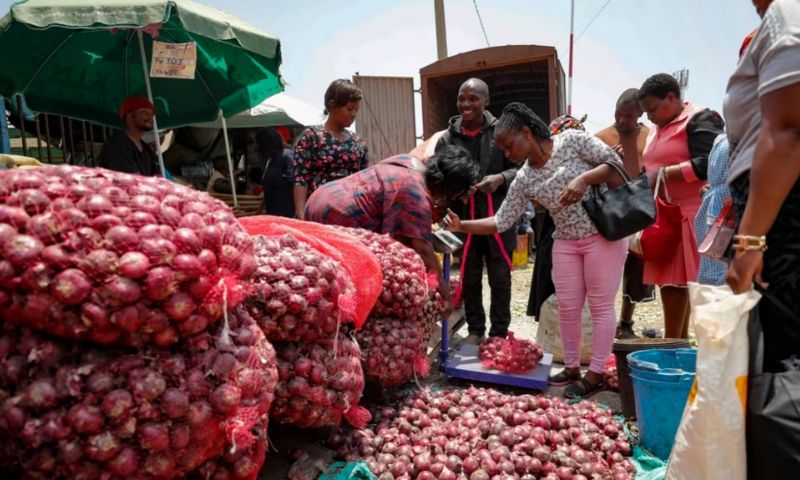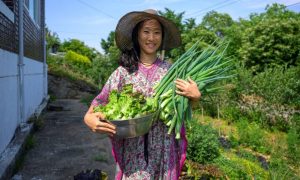NAIROBI, Kenya: In households worldwide, a pressing concern is arising — how to prepare a meal when essential ingredients become unaffordable.
This issue has been exacerbated by shortages of staple foods like rice, cooking oil, and onions. The situation stems from export restrictions imposed by various countries aiming to secure their domestic supplies due to a combination of factors: the ongoing conflict in Ukraine, the impact of El Niño on food production, and the escalating damage caused by climate change.
Caroline Kyalo, a 28-year-old working in a Nairobi salon in Kenya, grappled with the predicament of providing meals for her two children without onions. Export restrictions by neighbouring Tanzania caused the price of onions to triple, prompting Kyalo to explore alternatives like spring onions. However, even these options soon became too expensive, mirroring the surge in prices of other essential items such as cooking oil and corn flour. Consequently, she made the difficult decision to limit her daily cooking to once a day.
Despite Kenya’s fertile lands and ample workforce, the high costs associated with growing and transporting produce, coupled with the worst drought in decades, led to a decline in local production. Additionally, Tanzanian red onions, known for their affordability and longevity, became a preferred choice among consumers. By 2014, Kenya was sourcing half of its onions from Tanzania, according to a U.N. Food Agriculture Organization report.
At Nairobi’s major food market, Wakulima, prices for Tanzanian onions reached their highest point in seven years, highlighting the severity of the issue. While some traders adjusted by sourcing produce from Ethiopia or switching to alternative vegetables, others like Timothy Kinyua, a seller at Wakulima, continued to focus on selling onions, emphasizing their indispensable nature in daily cooking.
Tanzania’s restrictions on onion exports in the current year are part of a broader pattern of food restrictions observed globally. Fearful of supply shortages and increased demand for their produce, countries have implemented 41 food export restrictions, ranging from bans to taxes, according to the International Food Policy Research Institute.
India, for example, imposed bans on rice shipments earlier this year, resulting in a significant shortfall in global exports. The repercussions were felt in neighboring Myanmar, the world’s fifth-largest rice supplier, which responded by halting some rice exports. Similarly, India restricted onion shipments due to erratic rainfall caused by climate change, causing prices to surge in Bangladesh and prompting authorities to search for new sources of the vegetable.
In Spain, a drought significantly affected olive oil production, leading to a surge in olive oil prices as European buyers turned to Turkey. Morocco, grappling with a drought and a recent earthquake, halted the export of onions, potatoes, and tomatoes in February. This scenario showcases the intricate interplay between climate change, geopolitical conflicts, and food supply disruptions.
This is not the first time that food prices have experienced upheavals. In 2007-2008, prices for staples such as rice and wheat more than doubled, but the world had sufficient food stocks to manage the situation and replenish supplies in the following years. However, in recent years, this cushion has significantly reduced, and climate change threatens to quickly deplete food supplies, causing prices to skyrocket.
Experts predict that food prices worldwide will be determined by three primary factors: the impact and duration of El Niño, the occurrence of adverse weather affecting crops and prompting further export restrictions, and the outcome of the conflict in Ukraine. Both Ukraine and Russia are major global suppliers of key food commodities, particularly to developing nations where food prices have surged, leading to increased hunger.
El Niño, a natural phenomenon altering global weather patterns, can result in extreme weather events such as droughts or floods. Climate change is believed to be strengthening the intensity of El Niño, but its precise impact on food production remains uncertain until after it occurs. Early signs, however, are concerning, with India experiencing its driest August in a century and Thailand facing a drought that threatens the world’s sugar supplies.
The risks associated with climate change are not confined to rice; any crop or livestock requiring stable rainfall to thrive is at risk. Vegetables, fruit trees, and poultry are susceptible to heat stress, heightening the risk of food spoilage. These challenges further constrict food supplies. Moreover, if grain exports from Ukraine remain unresolved, additional shortages in livestock feed and fertilizer could exacerbate the crisis.
Russia’s withdrawal in July from an agreement ensuring safe transport of Ukrainian grain through the Black Sea has dealt a blow to global food security, leaving expensive and divisive routes through Europe as the primary option for Ukraine’s exports. The conflict has also adversely affected Ukraine’s agricultural production, with farmers scaling back planting of essential crops like corn and wheat.
























